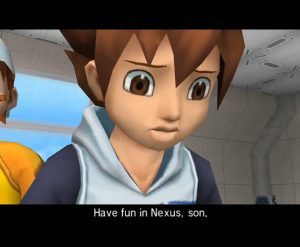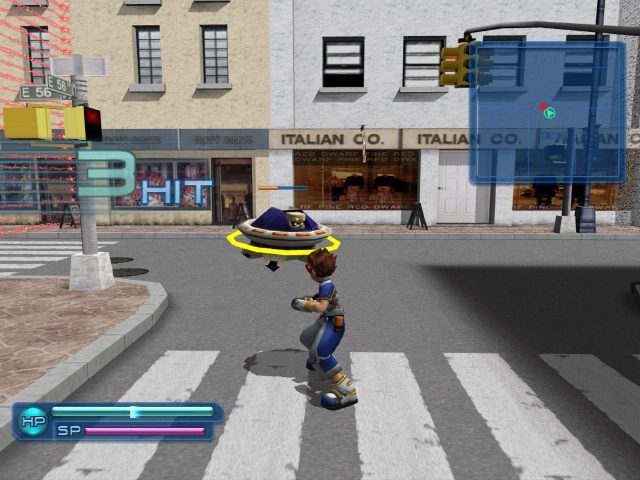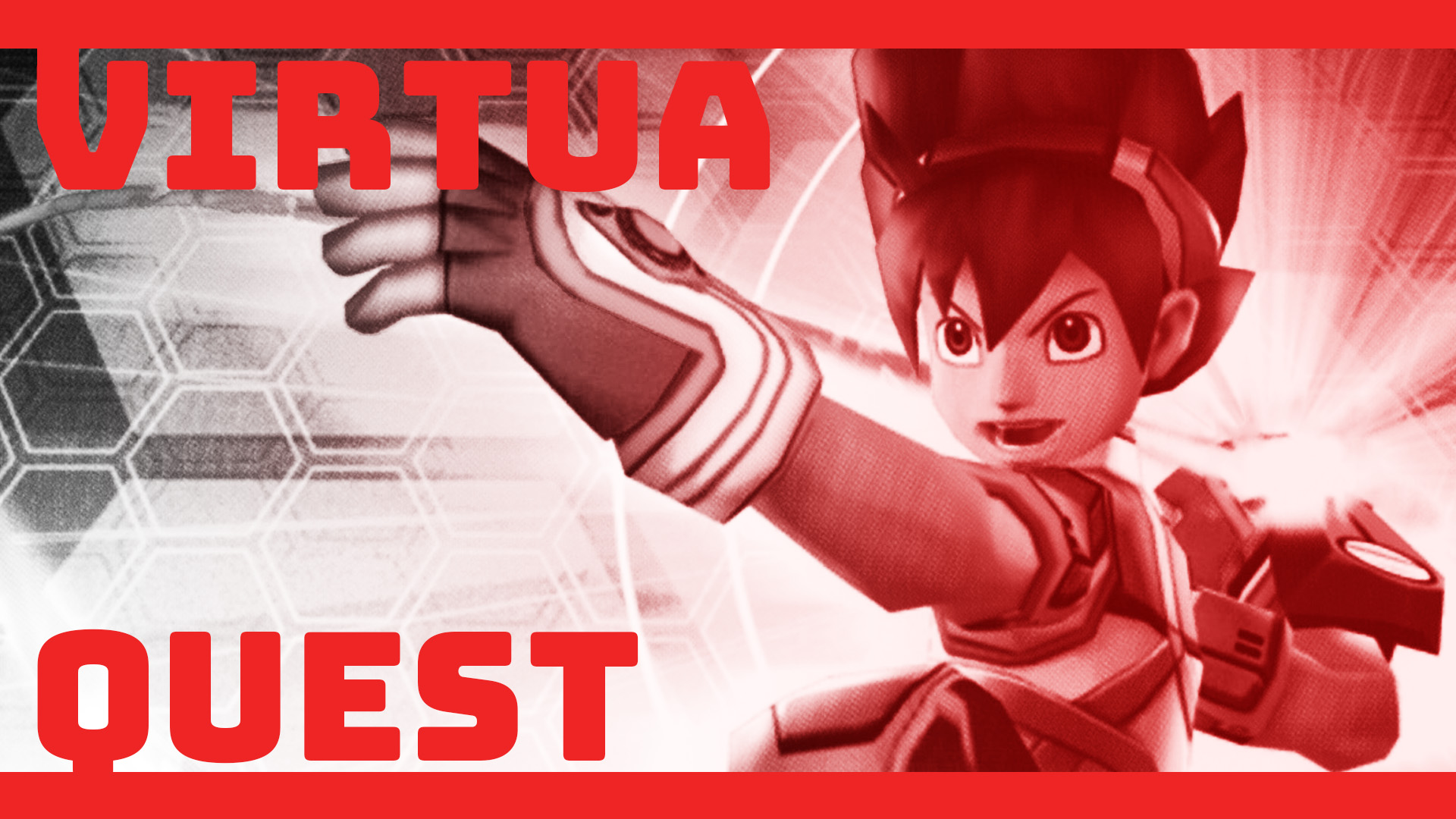I’ve mentioned it a few times on the podcast, but I love the Virtua Fighter series. Unfortunately, as a Nintendo fan, that puts me in a difficult position. See, the Virtua Fighter series has been absent from Nintendo consoles. There is, however, one noteworthy exception to this history of Nintendo exclusion: the action-R.P.G. spin-off game, Virtua Quest.
Virtua Quest was developed jointly by Tose co. and Sega AM2 and published by Sega. It was released in Japan under the name Virtua Fighter Cyber Generation: Ambition of Judgement Six on August 26, 2004 for the PlayStation 2 and GameCube. It was later released in North America on January 18, 2005. As mentioned before, it was a departure from the standard Virtua Fighter series in that the game is a beat-em-up with R.P.G. elements.
My history with this game is a little different than previous installments of That Was a Thing, as I’ve never actually played this game before. Well, not the full version at least. I knew about it way back when it first came out, due it being playable at the GameCube demo kiosk at my local Target. At the time, I thought the idea of a martial-arts-based action-adventure game was intriguing, but after seeing the middling review scores it received in the now-defunct Nintendo Power magazine, I ultimately decided to pass on it.
It wouldn’t be until a few years ago once I got into the Virtua Fighter series that I developed a renewed interest in this title. After over a year of searching, I finally stumbled across it while revisiting the GameXChange in my old, grad-school stomping grounds.
Virtua Story
Seeing as this is an R.P.G. spin-off, let’s start with the selling point of most R.P.G.s: the story. Virtua Quest’s story takes place an unspecified number of years (most likely decades, perhaps centuries) after the events of the main Virtua Fighter series. In this future, people attempt to escape the drudgery of reality by linking their minds to “Nexus”, a network of virtual worlds existing in cyberspace. As time wore on, some servers on Nexus were gradually abandoned and are now explored and scavenged by enterprising individuals known as “hunters” looking for data chips. Our protagonist, Sei, and his friend, Hayami, are two such hunters.
The game opens with Sei’s first hunt. It doesn’t exactly go smoothly and, after a brief altercation with the network’s automated security, Sei quickly bails. He returns to the real world to find a disappointed Hayami and a video message from his father stating that he won’t be home for his son’s birthday. As a consolation, he gifts Sei with a special, high-end (*cough* stolen, experimental, prototype *cough*) hunter’s glove, an essential piece of equipment for any Nexus hunter. Sei is eager to try it, so he heads back to the server he just escaped from.
Once there, he meets a mysterious girl who informs him that this server isn’t safe and that he should get out while he can. Without hesitating, he attempts to log out, only to find he can’t. He’s then instructed to meet with an accomplice of the girl, a man named Raud. Raud informs Sei will need the help of “Virtua Souls”, data that can grant users access to powerful martial arts moves. Sei quickly finds one and uses it to aid his escape. As he does so, however, he witnesses more masked marauders kidnapping other hunters.
From here, Sei escapes and embarks on a mission to track down more Virtua Souls and uncover the motives of the organization that attacked him.
Got all that? If you’ve ever seen a generic, product-licensed anime, especially one from the mid-2000s, then this should all sound pretty familiar. A 14-year-old kid gets a prototype gizmo from his scientist father and runs afoul of a mysterious, criminal organization along the way.
If you’ve ever seen a generic, product-licensed anime, especially one from the mid-2000s, then this should all sound pretty familiar.
That’s not to say the story is incompetently written. The narrative does a good job of spacing out the introduction of new characters and concepts and is pretty good about tying previously mentioned details back into the plot. Unfortunately, because the game’s story is so generic, its attempts at foreshadowing often backfire and tip the game’s hand, making some of its twists immediately obvious. That said, there is an overabundance of cutscenes during gameplay that take the player out of the action. So while the story is well-paced, it does tend to intrude on the pacing of the gameplay. Lastly, the world feels surprisingly fleshed out, with occasional newscasts painting a picture of the world beyond Nexus—as well as why people seek the escapism of Nexus.
Let’s move on to characters. First up is our lead, Sei. I both love and hate this kid. On one hand, he initially comes off as a spineless wuss who just does whatever he’s told without question. At the same time, Sei spends the first few levels of the game in a bit of a bewildered daze that’s both amusing and very believable. All the kid wanted was enough money to build a bike to compete in a race, and now he’s listening to pseudo-philosophical, anime soliloquies and fighting a globe-spanning organization attempting to control the world from the shadows. He reacts to his circumstances how most of us would with a combination of confusion, frustration, and sarcasm.

He eventually starts to fit into the hero role, but I suspect it’s partly him stepping up to the plate. I wouldn’t be surprised if halfway through the game he simply realized it’s easier just to humor everyone else. Case in point, the Virtua Fighters: when Sei first meets any of the Virtua Fighters, they tell their personal story, often ending with a poignant question. Sei’s answers often come across as him just telling the Virtua Fighter what they want to hear and not him attempting to take their life lessons to heart or think about the questions’ deeper meanings. Moreover, his motive for the first half of the game is ostensibly simple curiosity. He doesn’t start out trying to fight evil, he just wants to know what’s going on.
Unfortunately, the rest of the cast is pretty forgettable. All of the hero’s friends are pretty one-note, anime cliches: the annoyingly cheerful best friend, the mysterious girl who ropes the hero into the plot, the detective who’s trying to avenge his fallen partner, etc. The villains don’t fare any better. Most of the game’s bosses only show up once at the end of their respective levels and once more briefly for the end-of-game boss rush. They get no development and merely exist to give the protagonist someone to punch. This is especially disappointing because Judgment 6, the villains of the Virtua Fighter series, have never been directly shown in any of the games, so not learning more about the organization, its members, or its motives is a huge missed opportunity.
The villains get no development and merely exist to give the protagonist someone to punch.
Lastly is the Virtua Fighters themselves. Like J6, we don’t learn anything new about them. They just show up, give a bare-bones summary of their story, and teach Sei a special technique. They basically just amount to MacGuffins. Again, a massive missed opportunity.
My biggest issue with Virtua Quest’s story, however, is just how unfocused it is. Sei’s reason for visiting each stage is different every time: find out more about Virtua Souls, learn more about the mysterious girl, play a game with Hayami with a Virtua Soul as the prize, to locate someone’s lost brother, and so on. It’s not that these are bad reasons on their own, but they’re so disparate it lacks any sense of cohesion between chapters. The core of the issue is that the story has an episodic structure, but is presented in a serialized fashion. If they had a means of framing chapters, like having Sei log out, go to bed, and log back in the next day, the story would feel more cohesive.
Virtua Gameplay
Normally, I’d jump straight into a general overview of gameplay, but I need to address something right off the bat: the game makes a terrible first impression. The tutorial is long, boring, and intrusive. It’s then followed by a slog of a first stage, made worse by the fact that the player has next to no abilities—including some that would be available from the start in other games, such as dodging—and a lack of offensive options that lead to repetitive combat. Seriously, this part of the game takes about thirty minutes. Thankfully, it improves significantly after the first stage.
So what is the gameplay of Virtua Quest? Virtua Quest is a beat-em-up-R.P.G. hybrid. Stages task the player with reaching the end using a combination of combat, exploration, platforming, and puzzle-solving. Yeah, this was that odd era where game developers took an everything-but-the-kitchen-sink approach to game design. It was kind of surreal playing this because I had forgotten that this was fairly common design back in the day.
Anyway, the basic abilities at the players disposal are attacking, jumping, and blocking, pretty standard stuff. Oddly, the game deviates from the punch, kick, and block system of the Virtua Fighter series in favor of a single attack button and a button to activate Virtua Souls, which are special attacks that consume part of a power gauge. The player also has access to the ability to wall-run and a beam tether for added mobility. The last skill is known as the “synapse break”, which slows enemies who are launched into the air while it’s active and allows Sei to more fluidly chain attacks together at the cost of constantly draining the special gauge. In general, all of these abilities are used to good effect all throughout the game, with none being forgotten, though they do tend to be quartered off to their own segments.

Unfortunately, I can’t say it all fits comes together perfectly. My first issue with the game is its controls. None of the game’s three-button configurations feel natural, with block being assigned to a face button and the beam tether being activated by the C-stick. Note, the direction on the stick doesn’t impact on which way the tether launches, it just shoots the thing straight ahead.
Because the game doesn’t use the C-stick for its camera, that means the only way to control the camera is snapping it behind Sei with the L-button. If this weren’t cumbersome enough, the camera is placed just a little too close to Sei, making it hard to keep track of enemies during fights. I constantly had issues with being decked by enemies who charged in from off screen. The camera is hands down the worst thing in this game.
While we’re on the subject of controls, this game just feels clunky. For starters, there’s this weird pause before jumps where Sei stops and plants his feet. Realistic? Sure. Fun? No. Not to mention the player can’t link standard combos with Virtua Souls without having the synapse break active. If the game insists on a light attack, strong/special attack control scheme, it should let the player use strong attacks to end combos, much like the Yakuza games…which are developed by Sega…and got their start just a year later.
I’ve already briefly touched on the game’s stages, but I have to mention their length. Most of these stages are long. Like, 40-minutes without cutscenes long. To make matters worse, there are no proper checkpoints. There are save stations, but those are infrequent and often poorly placed.
As stated before, beat-em-up mechanics are only half of Virtua Quest’s formula. The game features numerous light-R.P.G. elements that allow the player to augment and customize Sei’s abilities. First of all, there are—of course—the Virtua Souls. Virtua Souls are hidden in each stage and can be used to customize the player’s move set, with progressively more powerful souls being available as the game progresses.
Next are upgrade tools, and the way they work is pretty cool in concept. Upgrade tools augment Sei’s abilities, either by granting new moves such as extending Sei’s basic combo or increasing Sei’s stats. What makes them interesting is every upgrade tool is composed of a 3D Tetrimino-like collection of cubes. Each of these cubes must then be fitted into a 3×3×3 grid, with the player getting a bonus to every stat if he can fill every space. I personally like the idea of this, as I’m pretty fond of such 3D puzzles, but in practice it does discourage experimentation as trying to figure out how to fit all of the best pieces together takes quite a lot of patience.
In practice the upgrade grid discourages experimentation as trying to figure out how to fit all of the best pieces together takes quite a lot of patience.
The other major issue is that there aren’t a lot of upgrade tools to collect, most of which are just stat upgrades. What’s really obnoxious, however, is that some of the early game upgrade tools are basic abilities that most games would’ve given the player from the start, for instance: dodging. That’s right, I had to equip the ability to dodge in a beat-em-up!
Aside from that, there is a slew of superficially R.P.G. elements. For starters, there’s a level-up system, but instead of affecting Sei’s stats, it’s just a ranking system used to lock some levels behind level requirements. Next, there’s a system that changes Sei’s fighting style. Note I didn’t say the player selects the style: it occurs automatically and is never even mentioned in-game until it happens. Lastly is the ability to customize Bit, the player’s robot companion. Feeding Bit different foods alters its stats and if Bit’s stats fall within certain parameters, it changes form and gains a new bonus ability. It’s a cool concept, but most of the abilities are only nominally useful; once I found the one I liked, I just stuck with it for the entire game.
Virtua Presentation
Visually speaking, Virtua Quest is fairly unremarkable. The game is graphically unimpressive for a GameCube title. Not surprising, considering it was also released on the less powerful PlayStation 2. Also, the animations and models don’t always look quite right. The cutscene were animated using motion capture that was way overacted. And I know I’m nitpicking when I say this, but when the characters aren’t waving their arms around like crazy, their shoulders look too narrow, almost like they’re bending in the wrong place.
The game’s greatest shortcoming, visually speaking, is the design. It’s just so…bland. Virtua Quest features a very generic visual style. The world uses the standard mid-2000’s post-cyberpunk aesthetic: holographic screens, white rooms with neon accents, dark blue menu screens with illegible, floating text in the background, etc. Despite taking place in cyberspace, the levels themselves aren’t futuristic, instead opting for such exciting locations as a jungle or a dockyard. None of the environments in this game are visually stimulating.
Likewise, the character designs scream “generic mid-2000’s licensed anime.” To add insult to insipidity, the main character’s design is somehow the worst one in the entire game. His upper body is covered in these weird, gray straps that make his torso too visually cluttered. His lower body is, likewise, over emphasized by the high waistline and loose cut of his Capri pants. Combined with his fitted top, this gives him a weird, off-putting silhouette. He just doesn’t have the strong, dynamic figure you’d expect from a game’s hero.

Alright, let’s talk about something good for a bit, the music. Admittedly, some of the tracks are fairly forgettable, most notably the music in the hunters guild lobbies, and some of it is really good. Each stage has both an exploration theme and a combat theme, and I often found that for almost every level I would like at least one of the tracks, if not both. Moreover, whenever you have to fight one of the Virtua Fighters, their theme from the main series plays. About half of the tracks are from Virtua Fighter 4, which I confess isn’t my favorite in terms of music, but the other half are the rearranged tracks from the Saturn version of Virtua Fighter 2, arguably the best soundtrack in a series whose music is held in high esteem.
While we’re on the subject of audio, let’s talk about the voice acting. While it starts off a little rough in the early game, it’s actually not that bad overall. It’s a little stiff at times, but I don’t think the actors lack skill or are phoning it in. For example Sei’s performance, provided by Kevin Miller of Sly Cooper fame, features some nice little touches here and there that help make Sei feel a bit more believable, lack having having Sei’s doing that weird sort of chuckle people do when they’re especially frustrated. If I had to hazard a guess, I’d say most of the issues with the voice acting probably would be because of direction or time constraints. Oh, and Charles Martinet is in this game!
Virtua Conclusion
At first glance, Virtua Quest is a misguided, designed-by-committee spin-off that failed to expand awareness for the Virtua Fighter series. Upon closer inspection, however, I can’t help but think many of the people on the team genuinely cared. The game has plenty of interesting ideas from a design perspective, and there are plenty of little details that suggest much the team wasn’t just phoning it in. Unfortunately, the game stumbles when it comes to basic things like the camera, fluidity of the controls, story focus, and so on. It’s a real shame, too; with some more polish and some quality of life improvements, this game could have had a fighting chance at being a worthy cult-classic.
Glen
Latest posts by Glen (see all)
- Goodbye, Two Button Crew - 12/28/2023
- TBC 40: The Legend of Zelda: Tears of the Kingdom - 12/27/2023
- TBC 039: Super Mario 64 - 09/28/2023


